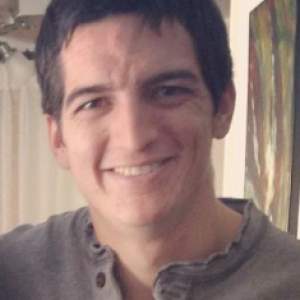Groh Lab
We investigate how the brain compares and fuses what we see with what we hear. Our research combines experimental and theoretical approaches to measure and manipulate neural activity while animals perform behavioral tasks.
Groh Research
How do our senses work together? Our eyes and ears cooperate to help us understand our environment. We frequently perceive visual and auditory stimuli as being bound together if they seem likely to have arisen from a common source. That's why we tend not to notice that the speakers on TV sets or in movie theatres are located beside, and not behind, the screen. Research in my laboratory is devoted to investigating the question of how the brain coordinates the information arising from the ears and eyes. Our findings challenge the historical view of the brain's sensory processing as being automatic, autonomous, and immune from outside influence.
The Brain and Space
Auditory Prostheses in the Brain
Over the last several decades, auditory prostheses have revolutionized the treatment of deaf patients. However, nearly all of this success has involved prostheses placed in the cochlea, in the ear, rather than in the brain. A subset of patients cannot use a cochlear implant due to structural problems with the cochlea or due to bilateral damage in the auditory nerve. These patients can only be helped by a brain prosthesis. Yet, the current generation of prostheses placed within the brain have not been as successful as cochlear implants: patients typically are not able to understand speech well enough to use the telephone (e.g. Lenarz et al., 2001; Colletti and Shannon, 2005; Tatagiba and Gharabaghi, 2005). This is true both of implants placed in the cochlear nucleus (the more commonly used site) and the inferior colliculus (more recently investigated in a small number of patients). Why these implants have not fulfilled their promise is not clear. This project seeks to shed light on what might be going wrong and how these problems might be solved. The project focuses on an animal model, the non-human primate, and is motivated by the idea that testing in an animal model affords opportunities for combined anatomical, electrophysiological, and behavioral approaches that would be difficult or impossible to conduct in human patients.
Groh Publications
Willett, Shawn M., and Jennifer M. Groh. “Multiple sounds degrade the frequency representation in monkey inferior colliculus.” The European Journal of Neuroscience 55, no. 2 (January 2022): 528–48. https://doi.org/10.1111/ejn.15545.
Schmehl, Meredith N., and Jennifer M. Groh. “Visual Signals in the Mammalian Auditory System.” Annual Review of Vision Science 7 (September 2021): 201–23. https://doi.org/10.1146/annurev-vision-091517-034003.
Caruso, Valeria C., Daniel S. Pages, Marc A. Sommer, and Jennifer M. Groh. “Compensating for a shifting world: evolving reference frames of visual and auditory signals across three multimodal brain areas.” Journal of Neurophysiology 126, no. 1 (July 2021): 82–94. https://doi.org/10.1152/jn.00385.2020.
Glynn, Chris, Surya T. Tokdar, Azeem Zaman, Valeria C. Caruso, Jeff T. Mohl, Shawn M. Willett, and Jennifer M. Groh. “ANALYZING SECOND ORDER STOCHASTICITY OF NEURAL SPIKING UNDER STIMULI-BUNDLE EXPOSURE.” The Annals of Applied Statistics 15, no. 1 (March 18, 2021): 41–63. https://doi.org/10.1214/20-aoas1383.
Mohl, Jeff T., John M. Pearson, and Jennifer M. Groh. “Monkeys and humans implement causal inference to simultaneously localize auditory and visual stimuli.” J Neurophysiol 124, no. 3 (September 1, 2020): 715–27. https://doi.org/10.1152/jn.00046.2020.
Kopčo, Norbert, Peter Lokša, I-Fan Lin, Jennifer Groh, and Barbara Shinn-Cunningham. “Hemisphere-specific properties of the ventriloquism aftereffect.” The Journal of the Acoustical Society of America 146, no. 2 (August 2019): EL177. https://doi.org/10.1121/1.5123176.
Caruso, Valeria C., Jeff T. Mohl, Christopher Glynn, Jungah Lee, Shawn M. Willett, Azeem Zaman, Akinori F. Ebihara, et al. “Single neurons may encode simultaneous stimuli by switching between activity patterns.” Nature Communications 9, no. 1 (July 13, 2018): 2715. https://doi.org/10.1038/s41467-018-05121-8.
Gruters, Kurtis G., David L. K. Murphy, Cole D. Jenson, David W. Smith, Christopher A. Shera, and Jennifer M. Groh. “The eardrums move when the eyes move: A multisensory effect on the mechanics of hearing.” Proceedings of the National Academy of Sciences of the United States of America 115, no. 6 (February 2018): E1309–18. https://doi.org/10.1073/pnas.1717948115.
Caruso, valeria, daniel Pages, M. A. Sommer, and jennifer Groh. “Beyond the labeled line: variation in visual reference frames from intraparietal cortex to frontal eye fields and the superior colliculus.” Journal of Neurophysiology In Press (December 20, 2017). https://doi.org/10.1152/jn.00584.2017.
Pages, Daniel S., Deborah A. Ross, Vanessa M. Puñal, Shruti Agashe, Isaac Dweck, Jerel Mueller, Warren M. Grill, Blake S. Wilson, and Jennifer M. Groh. “Effects of Electrical Stimulation in the Inferior Colliculus on Frequency Discrimination by Rhesus Monkeys and Implications for the Auditory Midbrain Implant.” J Neurosci 36, no. 18 (May 4, 2016): 5071–83. https://doi.org/10.1523/JNEUROSCI.3540-15.2016.
Lab Members
Alumni
Groh Opportunities
POSTDOCTORAL POSITION AVAILABLE
A postdoctoral position is available to study spatial processing in the auditory and visual systems of the brain. Several different research questions are available for study: visual influences over hearing; coding of multiple sounds; and the role of parietal cortex in connecting spatial locations across time. A strong quantitative background is essential. Experience in neurophysiology, animal training, and/or auditory psychophysics is preferred.To apply, please email plain text cover letter including the names of 2-3 references and CV to jmgroh@duke.edu. (Posted October 2014).
GRADUATE STUDENT OPENINGS
I anticipate an opening for a graduate student for the fall of 2015. Most of my students come from one of the following programs: Psychology and Neuroscience, Neurobiology, or the Cognitive Neuroscience Admitting Program. I encourage interested applicants to contact me at: jmgroh@duke.edu and to consider taking my Coursera course on "The Brain and Space". This course will give you a taste of how I like to think about the brain as well as an introduction to some of our scientific discoveries and those of other researchers.
Contact Groh Lab
Center for Cognitive Neuroscience
LSRC Rm. B203
Box 90999
Duke University
Durham, NC, 27708
Phone: 919-681-6536
Fax: 919-681-0815
Email: jmgroh@duke.edu

